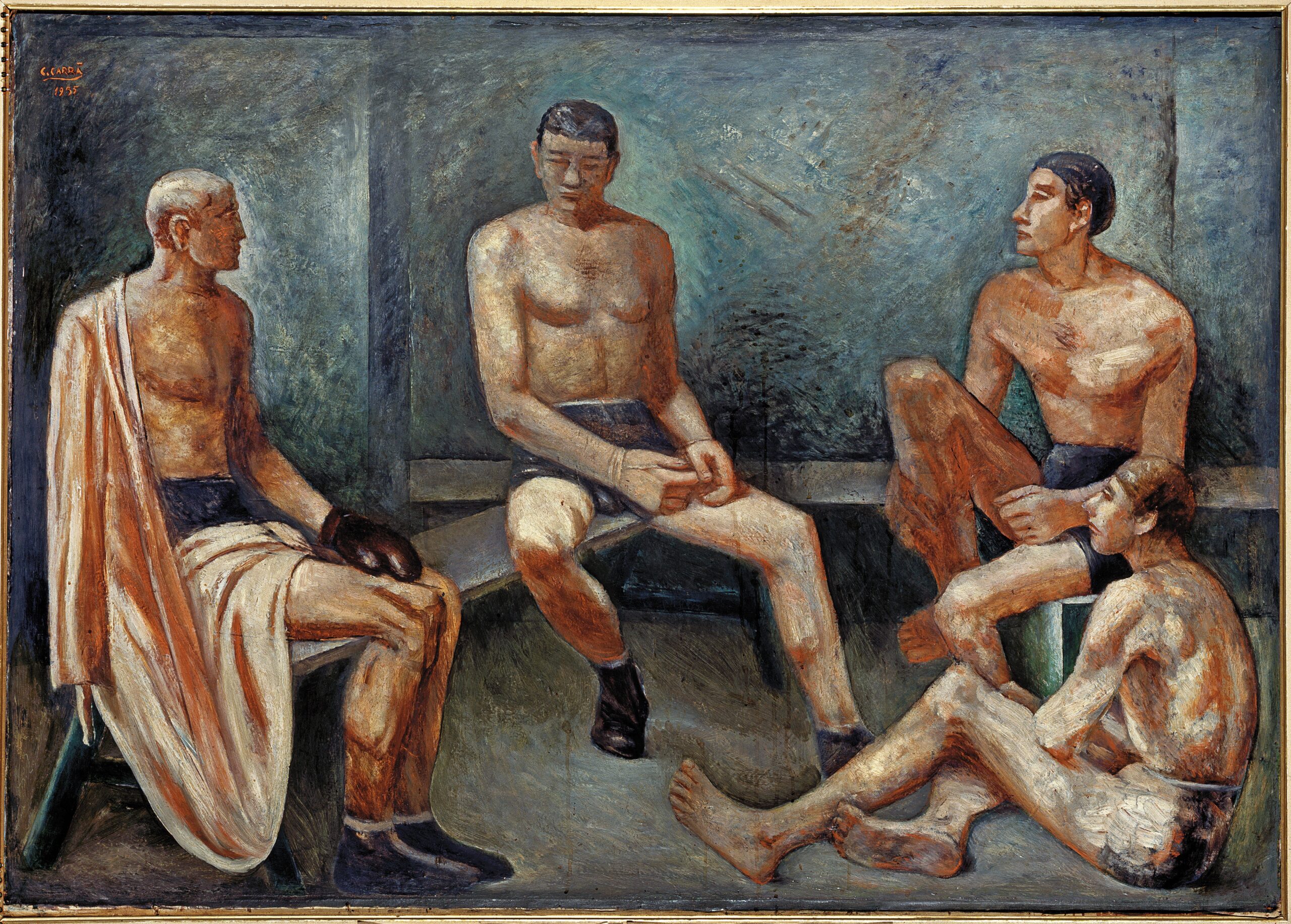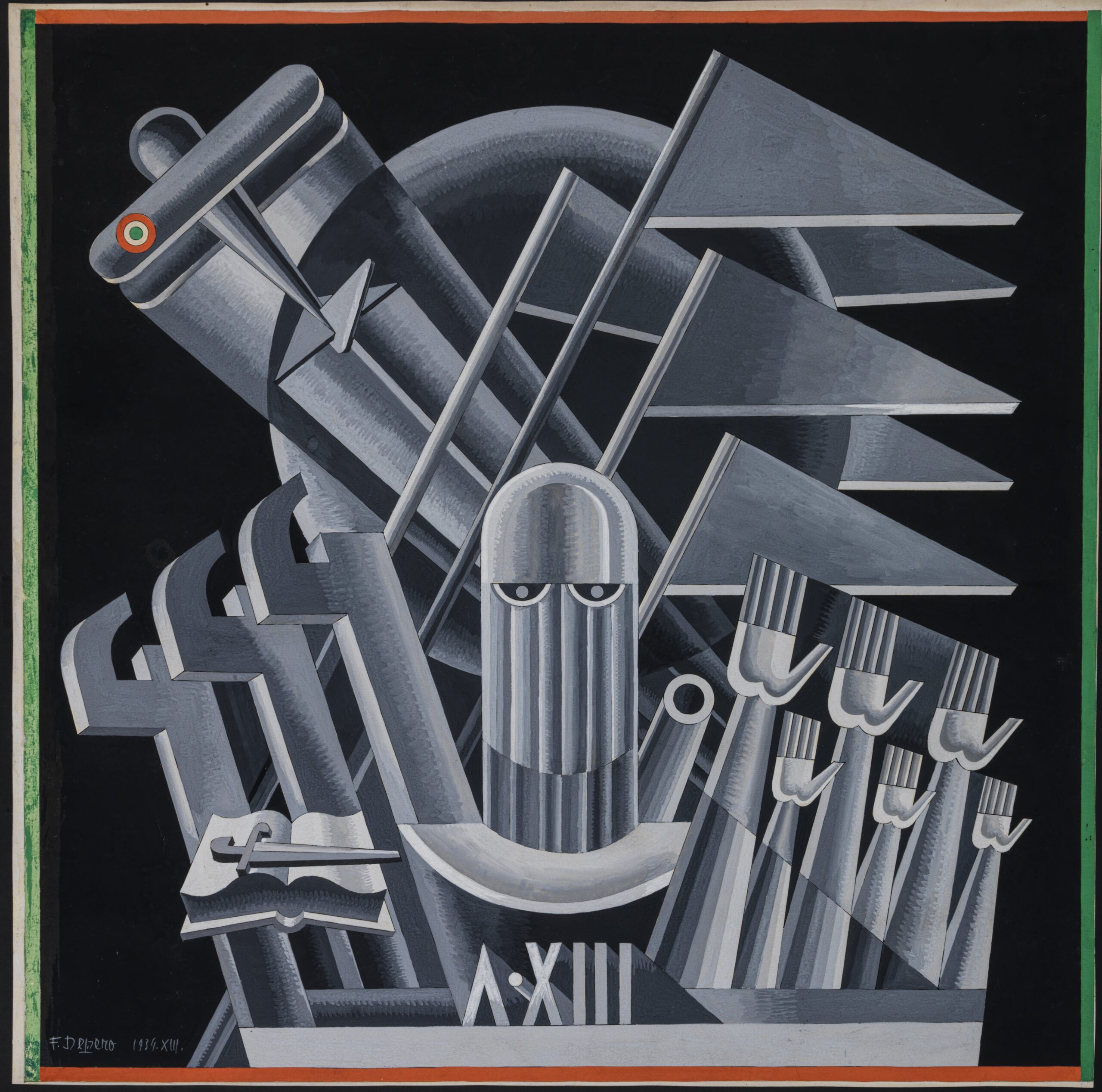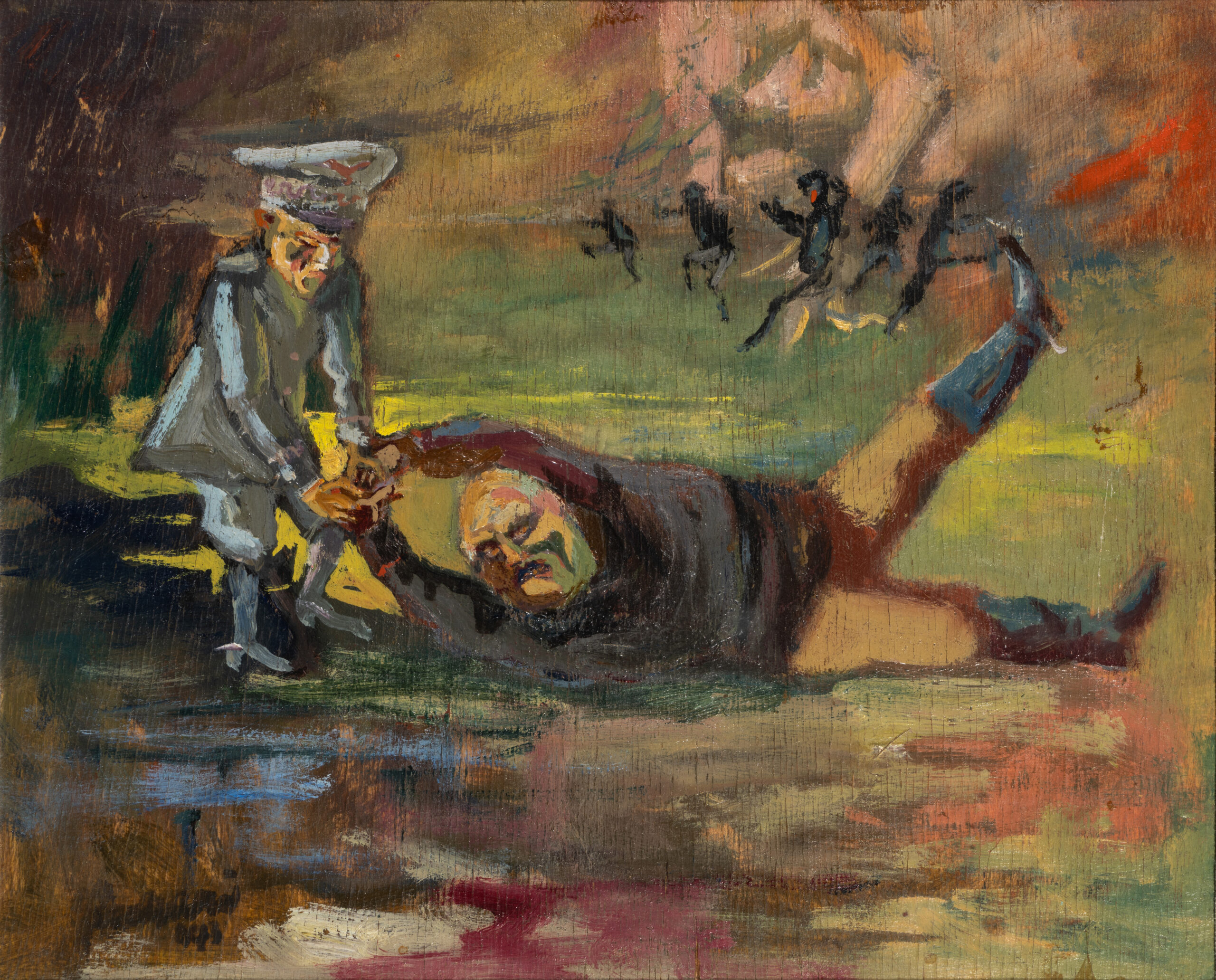
C. Carrà, Atleti a riposo
Looking at artworks created during the fascist regime, I have often found myself pondering how fascism influenced the figurative culture of that particular historical period and what was the relationship between art and fascism.
So how did the complex system of art develop during the 20-year fascist period and how did artists give voice to the myths and themes of fascism?
In this post I will attempt to answer this question by describing a complex and still little-studied period.
The link between art and fascism in Italy

Fortunato Depero Duce nel mondo, 1934 Mart, Fondo Depero
In order to understand what the relationship between art and fascism in Italy was, one must first recall “Novecento Italiano,” a movement promoted by Margherita Sarfatti during the very period when Mussolini gained power in Italy.
The movement in fact advocated a return to the ancient and greatness of the Italian tradition, in absolute harmony with the ideals of early fascism. However, there was also a predilection for the themes of family, sports and labor as fundamental pillars of Italian society, which Fascism promoted and tried in every way to enhance.
In the late 1930s, an art aimed at building consensus began to prevail, and an organized system was built to regulate art through unions, associations, competitions and awards.
We can say that Fascism attempted to harness art in a regulated system to promote its ideals and to spread them throughout the country.
POWER AND ART
Margherita Sarfatti was an interesting personality and played a leading role in orienting Benito Mussolini toward an interest in the figurative arts, who in fact did not fail to attend the opening of the most important art exhibitions in Italy and declared several times that he wanted to encourage a state art.
Sarfatti became, therefore, the animator of the group called “Novecento Italiano,” which included Funi, Malerba and Sironi, among others. Each artist paints in a different style but all adhere to that idea of limpid and composed art defined by Margherita Sarfatti, contributing to the construction of an artistic style.
During the 20-year fascist period there is a wide dissemination of the image of Benito Mussolini.
His portraits and sculptures are used for propaganda purposes and to build consensus, exalting physiognomic and character traits, which become true metaphors of power.
We can also note a certain evolution of Mussolini’s iconography that follows the historical events in which he is a protagonist. In the portraits of the 1920s, in fact, Mussolini is portrayed in bourgeois and monumental clothes, emphasizing his imperialist ambitions, but in the following years the image of the Duce gradually changes and he becomes a hero and a leader, but also a figure as strong as metal and with a like progress.o look towards the future and the radiant progress that awaits Italy.
THE RELATIONSHIP BETWEEN ART, FASCISM AND FUTURISM
Mussolini therefore always sought to build his consensus by exploiting art to his advantage, and the harmony between Mussolini and Filippo Tommaso Marinetti, a leading exponent of Futurism, will be strong. Both were fascinated by each other but endowed with personalities too strong to work together.
Fascism and futurism share the myth of action and mechanical means, of war and the fascination with technique.
In the 1930s, the artists of the aeropainting movement and the artists of the second season of futurism embrace the propaganda needs of the regime, celebrating its ideals. However, futurism failed to carve out a leading role for itself in fascism’s cultural policy, and this is evident from the modest amount of futurist works that became part of public collections and the limited involvement of such important artists as Giacomo Balla and Fortunato Depero.
Futurism never became state art, but it was instrumental in founding a modern aesthetic in Italy.
The Futurists, in fact, devised an innovative language, exploiting mass-produced images and amplifying the fascist ideals, which they shared.
THE ARTS SYSTEM DURING THE 20-YEAR FASCIST PERIOD
Futurism also failed to become state art because fascism, unlike other dictatorships, preferred to control artistic production through a system of awards, grants and exhibitions.
This was a new way of promoting the arts, which appealed to spontaneous adherence to fascist ideals.
Fascism did not impose but made art adhere to its ideals, guaranteeing the plurality of languages and styles, at least until 1938. We can say that most artists were able to benefit from the support given by the regime to the development of the arts.
It was precisely this way of conceiving support for art by Fascism that gave rise to many new exhibitions: the Triennale in Milan, the Quadriennale in Rome and the Venice Biennale.
It was only after the promulgation of the racial laws that artists of Jewish origin were denied the right to exhibit, design, teach and sell their works.
THE NEW MYTHS OF ART
Fascism suggests new themes to art that build a narrative of a country of laborers, athletes and heroes. In works of art created during the Fascist twenty-year period, the body becomes trained and always oriented toward movement and competition.
The cult of the body originates from the classical tradition, and modern sports disciplines lent themselves to physical descriptions that could recall those of the athletes of the classical era.
Sport during Fascism is considered one of the values of Italian society, and there are many works celebrating swimmers, soccer players, wrestlers, and athletes of various kinds. These are depicted in a monumental way and their bodies are quite similar to those of a worker, and both find a place in the art of the Fascist twenty-year period.
Work, family, and the cult of the body are the favorite subjects of the artists of this period, depicting a society all about strength and progress.

Mussolini trascinato dal re (Serie Dux), 1943. Collezione Luisa Laureati Briganti
THE END OF THE TWENTY-YEAR PERIOD
After the years of celebration comes the time when some artists express a harsh criticism that was hitherto unthinkable.
Between the end of the 1930s and the beginning of the 1940s a drastic change of course takes place and the Duce no longer appears as a condottiere is a hero, but rather as a caricature.
Artist Mino Maccari in 1943 presented the “Dux” series, in which the glorious figure of the Duce appears as a grotesque parody. This is not the only example; Mussolini appears again and again in drawings, paintings and sculptures as a silhouette to be laughed at and mocked.
At the end of the regime, his symbols fall: the effigy of the dictator that had been an object of worship is struck down by the fury that accompanies the decline of every tyranny.
Hematic was the damage to the bronze “Dux” bust of Adolfo Wildt by partisans during the days of Liberation.

